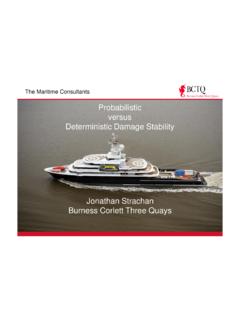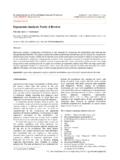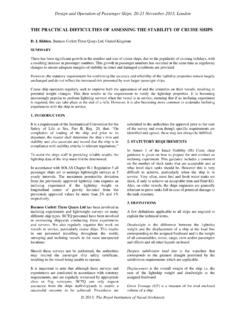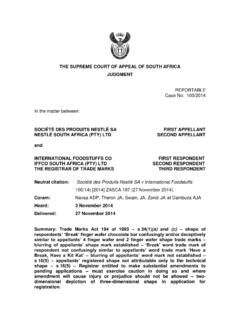Transcription of Whole-body vibration and ergonomics toolkit - …
1 Executive Health and Safety Whole-body vibration and ergonomics toolkit Phase 1 Prepared by the Health and Safety Laboratory for the Health and Safety Executive 2008 RR612 Research Report Executive Health and Safety Whole-body vibration and ergonomics toolkit Phase 1 A M Darby BSc(Hons) MSc CPhys MInsP Health and Safety Laboratory Harpur Hill Buxton SK17 9JN The exact cause of back pain is often unclear but back pain is more common in jobs that involve certain tasks, one of which is driving. Driving exposes the vehicle s occupants to Whole-body vibration and in some cases shocks and jolts, factors which are believed to increase the likelihood of injury or pain in the lower back. The report describes a Whole-body vibration and ergonomics toolkit that has been developed for use in assessing driving occupations. The objectives of this report are: n to provide a guide on how to approach the control of back pain due to occupational exposure to Whole-body vibration and ergonomic risk factors; n to invite recommendations on how the toolkit detailed in the report can be improved for the vehicles and occupations of interest; and n to provide a specification for future Whole-body vibration data collection activities.
2 This report and the work it describes were funded by the Health and Safety Executive (HSE). Its contents, including any opinions and/or conclusions expressed, are those of the author alone and do not necessarily reflect HSE policy. HSE Books Crown copyright 2008 First published 2008 All rights reserved. No part of this publication may be reproduced, stored in a retrieval system, or transmitted in any form or by any means (electronic, mechanical, photocopying, recording or otherwise) without the prior written permission of the copyright owner. Applications for reproduction should be made in writing to: Licensing Division, Her Majesty s Stationery Office, St Clements House, 2-16 Colegate, Norwich NR3 1BQ or by e-mail to ii CONTENTS 1 1 Background .. 1 Development of the toolkit .. 2 Aims of the report .. 3 2 toolkit - Whole-body 5 3 toolkit - ANTHROPOMETRIC DESIGN 7 Taking measurements.
3 7 Calculating percentile ranges .. 10 Suitability of the cab for a specific operator .. 10 4 toolkit - POSTURE ASSESSMENT .. 11 5 toolkit - MANUAL HANDLING ASSESSMENT .. 15 6 toolkit - MUSCULOSKELETAL DISORDERS QUESTIONNAIRE .. 19 7 FUTURE WORK .. 21 8 23 APPENDICES .. 25 APPENDIX A. vibration DATA FOR VEHICLES IN 27 APPENDIX B. ANTHROPOMETRIC PROFORMAE AND SPREADSHEETS 65 APPENDIX C. POSTURE ANALYSIS .. 79 iii iv EXECUTIVE SUMMARY The exact cause of back pain is often unclear but back pain is more common in jobs that involve certain tasks, one of which is driving. Driving exposes the vehicle s occupants to Whole-body vibration and in some cases shocks and jolts, factors which are believed to increase the likelihood of injury or pain in the lower back. The report describes a Whole-body vibration and ergonomics toolkit that has been developed for use in assessing driving occupations.
4 The objectives of this report are: o To provide a guide on how to approach the control of back pain due to occupational exposure to Whole-body vibration and ergonomic risk factors. o To invite recommendations on how the toolkit detailed in the report can be improved for the vehicles and occupations of interest. o To provide a specification for future Whole-body vibration data collection activities. v vi 1 INTRODUCTION BACKGROUND Musculoskeletal disorders are the most common form of ill health at work. According to HSE s website (Back pain), it is estimated that million working days (full-time equivalent) were lost in 2003/2004 due to musculoskeletal disorders mainly affecting the back that were caused or made worse by work. The fact that back disorders are the most common form of ill health at work is one reason why HSE has made reducing their prevalence a priority.
5 The exact cause of back pain is often unclear but back pain is more common in jobs that involve certain tasks, one of which is driving, especially over long distances or over rough ground. Driving exposes the vehicle s occupants to Whole-body vibration , and possibly shocks and jolts, factors that are believed to increase the likelihood of injury or pain in the lower back. However drivers may also be exposed to other factors which may cause lower-back pain such as poor posture while driving and manual handling while loading and unloading goods. The work reported here is the first phase of a project looking at Whole-body vibration exposure and other ergonomic risk factors for back pain from driving occupations. The project is an exploratory study of back pain in drivers. The limited sample size of the study means that it will not be possible to draw strong conclusions about relationships between exposure data and self-reported musculoskeletal disorders.
6 However as future studies use the data collection protocol developed during this project to add to the library of data, it will be possible to analyse the records for evidence of possible combined effects of Whole-body vibration and ergonomic stressors as sources of back pain. The project will: o collect typical daily exposures for comparison with the exposure action and limit values for Whole-body vibration specified in the Control of vibration at Work Regulations 2005; o assess the significance of confounding factors for risk of back pain in drivers; and o consider the relationship of back pain with Whole-body vibration quantified by various standard methods. The project is organised into three phases . The first phase, which is reported here, involves the testing and development of a prototype toolkit of data gathering and confounder screening techniques to a number of different vehicles.
7 phases 2 and 3 involve data gathering using the toolkit and investigation of relationships of back pain with occupational driving, respectively. The toolkit was developed by specialists in HSL in association with HSE Specialist Inspectors. It seeks to provide a standard data collection procedure for Whole-body vibration that provides for establishing the likelihood of manual handling or posture being significant causes of back pain. The toolkit comprises: o Whole-body vibration data acquisition and analysis system; o a base set of measurements of workstation (driving position) dimensions to assess the adjustability of the workstation to accommodate the operator or range of operators 1 employed; o HSE s Manual handling Assessment Charts (MAC) to rate severity of manual handling tasks; o video analysis to assess postures and frequency of adoption; and o a questionnaire (based on the validated Nordic questionnaire) recording self-reported musculoskeletal disorders (MSDs).
8 DEVELOPMENT OF THE toolkit Phase 1 of the project, which is reported here, involved testing, and further developing where necessary, the prototype toolkit by applying it to a number of different driving occupations. The occupations selected were tipper truck driver, delivery van driver, forklift truck driver, council tipper truck driver, and council signage (flat back transit) van driver. The cabs of the vehicles used by these drivers were easy to access, and in most cases it was possible to spend up to three quarters of an hour fitting equipment and measuring the interior of the cab for the anthropometric assessment. Accessibility, both physical and in terms of time, of the cabs was particularly important at this assessment and development stage of the toolkit . For four of the vehicles two members of staff, neither of whom was an ergonomics specialist, attempted to make all the measurements required by the toolkit .
9 The use of non-specialists was important as the toolkit is intended for use by non-ergonomists. However in one case a third scientist was involved in the visit to reduce the amount of time required to acquire the necessary data. Whole-body vibration The Whole-body vibration measurement and analysis system was expanded from three to seven channels of data, three on the seat pan, three on the seat base (in the same three orthogonal directions as the seat pan), and one on the seat back (in the fore-aft direction). This allows the SEAT (seat amplitude transmissibility) factor of the seat, for the vertical and two lateral directions, to be determined; thereby allowing the transmissibility of the seat to be assessed for all three directions. The analysis software was also enhanced to determine additional vibration metrics such as the Maximum Transient vibration Value (ISO 2631-1:1997) for each channel and spine response data (ISO 2631-5:2004).
10 In addition the analysis software now produces resampled time history and cumulative vibration Dose Value plots for each channel of data. Anthropometry The anthropometric proforma in particular underwent substantial development as a result of the site visits. During the initial measurement visit it became clear that there was insufficient time available for the two staff on site to take all the measurements required by the proforma, in conjunction with the other tasks that needed to be completed. This conclusion was based on the premise that in this type of work a loss of production of about half to three quarters an hour at most is tolerated. Sixty separate measurements were required by the initial anthropometric proforma and associated spreadsheet. The seat, and where appropriate the steering wheel, had to be adjusted during the measurement sequence so that various maximum and minimum distances could be measured.
















